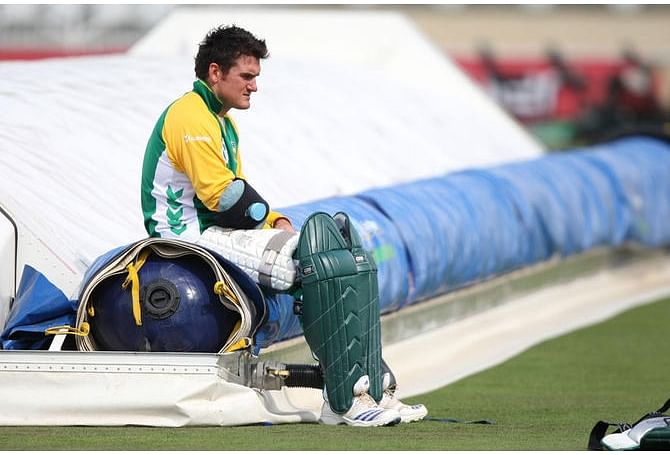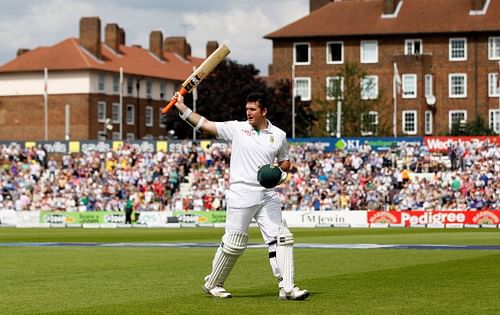
Graeme Craig Smith - The Definitive Test Captain
Hansie Cronje, one of the famous captains ever produced by South Africa, became infamous for the match fixing scandals. He is still celebrated as a scintillating figure in the hearts of South African cricket supporters for his heroics in leading the ODI team with consistent results. But he always wished to see South Africa tagged as a successful Test cricketing nation. Of course, everyone wants their team to do well in the purest form of the game. He is not alive today but his wish has almost been granted. Yes, the South African Test team has achieved heights in the last 8 years or so and all credits go to one man who has transformed himself from a 22-year-old rash youngster to the matured leader of the world no-1 Test team.

A rookie is given a chance when the line up is strong, but here is a rookie who was requested to lead his side in all formats, when his own slot in the Test team was yet to be consolidated. Thanks to some poor mathematical skills of Pollock at Durban, it brought Smith in to the limelight. All Smith had at that time was a class all rounder in Kallis, a few reliable batsmen batting around Kallis, an ageing attack spearheaded by Pollock with an enthusiastic Ntini and a few passengers here and there. But he knew when Stephen Fleming could do it for New Zealand at a similar age, he could do it as well.
Smith’s first assignment was away from home against a less than competitive Bangladesh. He won the series and gained some breathing space in the set up. What followed that series was massive – South Africa’s tour of England (2003). 4 Tests at premier venues in England, the cricket world was watching and some analysts even predicted a 3-0 win for England. Nasser Hussain attended the press conference before the first Test and when he was asked to comment on the new South African set up, it was a formal reply given by every other Test captain in the modern era, but the second part of the reply had something to do with Smith. His reply was – “This team can be dangerous on any given session, they have some fresh energy led by….who’s that guy?” Yes, he forgot the name of his counterpart. But after the events that followed in the next five days, he would never forget Smith in his life. 277 and 85- these were Smith’s scores in the 1st Test at Edgbaston and he registered his first win in England. On the other side of the camp, Hussain resigned. Smith didn’t stop there, he went on to score a massive 259 at Lords in the 2nd Test, breaking Bradman’s record for the highest score made by a foreign batsman at the venue, a record which holds good even today. Thus a second Test win and a series lead of 2-0 in a five match series. But the South African team was not good enough to hold on to the advantage and they drew the series 2-2. Smith was awarded the Man of the Series and Alec Stewart quipped,” Smith is the most impressive 22-year-old captain that I have ever seen”. At the end of the tour, Smith concluded within himself that the best way to lead this team was to lead with his batting upfront.
Winning matches at home was never a problem for South Africa as it always had a renowned pace attack to finish things off, but Smith insisted upon winning Test matches away from home. He lost to Pakistan, Srilanka and India away from home in 2004 but series wins in New Zealand and West Indies were more than enough for his employers to keep him in the job for the rest of the season in 2004-05. But the most horrible period of his Test captaincy was to come with an Australian tour. The series was a nightmare for Smith as he was bullied by the hosts’ media and spectators at all venues and got a 3-0 defeat. When he requested to the Australian board for a 5 match series, a famous channel nine presenter even went on to say that Smith should draw a Test here before talking about a 5 match series status. Smith confronted a hostile media session at Sydney after a 3-0 loss and accepted that Australia is the most difficult place to tour as a cricketer and he would love to win a Test match there some time. One should know that this was his last series defeat on tour and he has never lost an away series since 8th January 2006.

It was at this point of time he made three classical decisions as a Test skipper to build individuals and a culture for the team. First one was to keep Amla in the line up despite his poor technique, second one was to pull in De Villiers as a regular member of the Test side and the third one was to drop Steyn to give him some time to develop his Test bowling skills. Now we realize why these decisions are meant to be classical. He wanted Steyn to replace Pollock as his spearhead, and reduce the pressure on Kallis by handing over more responsibilities to Amla and De Villiers in the batting order. Steyn came back with an updated action, Amla with an updated backlift and De Villiers with an updated temperament needed for Rest cricket. And Smith came out as a renewed skipper, ready to go for another ride. A 1-0 victory in Pakistan, 2-0 victory in West Indies and a 1-1 tie in India followed. He effected a tie in India twice in a row (2008 & 2010), becoming the first captain to come and leave the country without a series defeat. But the ultimatum was to win in England and Australia, a dream for any Test skipper.
It was in 2008 when Steyn was at his peak, and Smith knew that they could take 20 wickets anywhere on the planet. But he was about to draw the series opener at Lords against England in 2008, where he decided to score a 2nd innings ton himself along with Amla and settle for a draw. It was his second ton at the Mecca of cricket. De Villiers’ century (174) and a Morkel-Steyn combo of 14 wickets gave them the lead at Headingley in the second Test and the team headed to the 3rd Test at Edgbaston- England’s fortress – with a 1-0 advantage. And Edgbaston witnessed a determined Smith who went on to score a second innings 154 n.o to chase down a tricky 283 after losing 4 wickets for less than 50 runs. The series was sealed 2-0 for South Africa and Vaughan resigned. He conquered the English for the first time. Smith didn’t stop there, he took the momentum to Australia. The first Test at Perth witnessed a world record chase in Test cricket. Thanks to those 4th innings hundreds from Smith himself and De Villiers. The second Test at the MCG was won thanks to that 10 wicket haul from Steyn and a memorable 166 from Duminy. It was 2-0 win for South Africa and Smith became the first captain to beat Australia in Australia in nearly two decades since the legendary Windies did it way back in the 90′s. But it was in the third Test at Sydney, where Smith played his heart out for the country by coming in to bat with a broken hand even after winning the series. One could still remember Mark Nicholas and Shane Warne‘s appreciation for Smith on air on Channel 9. The whole SCG crowd had goosebumps when they saw Smith coming out to bat at no-10 with a broken hand. They stood up for him and he earned respect from a cricketing nation which respects its opponents very rarely. Finally, he had conquered Australia where he had been humiliated a few years ago. By this time all his boys had transformed in to men. They knew their roles and they were aware of what was expected out of them in various situations.
Two out of those three classical decisions worked out in 2008 and the third one was yet to give him results. And when the third decision (the one on Amla) worked out, South Africa was number one and Graeme Smith was holding the Test mace. Apart from nurturing players, he is known for the rapport that he builds with the team coaches and staffs. He has never failed to acknowledge the staff behind the scenes during the post match presentations. He redefined Kallis’ batting career by conveying the message that he is no more an individual leg balancing the table, but that the table has got some other reliable legs now. This has enabled Kallis to flourish more like an attacking batsman at no-4 with more freedom.

Every cricketer dreams about playing 100 Test matches for his country and here we have a bloke who has led his team in 100 Tests with a win percentage close to 50, a mighty record by any means. If he was presented with a settled team and the stats are analysed from 2007, then his win percentage might show up a massive 76, the highest for a captain in the history of Test captaincy. South Africa has never lost a Test match when Smith has scored a century and it was even tested in Adelaide recently when a rookie like Du Plessis came to the party with a brilliant 100 and said we will never lose a Test when our captain scores a century. Such has been the influence that Smith has on his team as a batsman.
If he could win the 2nd Test against Pakistan this weekend, he will become the captain with most number of wins in the history of the game, breaking Ponting’s record of 48 wins. He has always been one of the less celebrated cricketers around the world, the prime reason is his place of birth where the game is not quite popular. He might have been a legend elsewhere. Still he has at least 3 years left in him to reserve a page for himself in those history books. He might not be leading the list of tactical captains, but he is an institution of Test captaincy, a title which demands perseverance, determination and grit to get results.